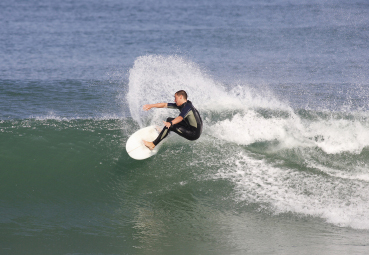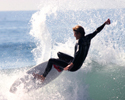Stringer
Flex Is Surfing's Hot Topic
One important property of a modern surfboard we often overlook is flex. This is now a hot topic in surfboard design. Surfers are starting to understand how surfboard flex affects our surfing and which design characteristics increase flex memory. Shapers everywhere are responding to this increased interest.
 Flex allows your surfboard to build energy through turns when the surfboard's materials change shape. Picture this sequence: You drop into a fast, steep bottom turn. As you do so your surfboard's foam will bend into the turn. This results in more rocker and stored energy. As you come out of this turn and aim for the lip the foam snaps back to its original shape, releasing the stored energy and shooting the surfer out of the turn. A seasoned surfer will turn this burst of energy into acceleration, propelling himself into the next maneuver. While the flex characteristics can help your surfing, creating a surfboard design with flex in mind presents challenges. First, the surfboard must walk the line between flex and strength. Secondly, after repeated compression and expansion, a surfboard's traditional wood stringer will weaken, giving it a "dead" feeling.
Flex allows your surfboard to build energy through turns when the surfboard's materials change shape. Picture this sequence: You drop into a fast, steep bottom turn. As you do so your surfboard's foam will bend into the turn. This results in more rocker and stored energy. As you come out of this turn and aim for the lip the foam snaps back to its original shape, releasing the stored energy and shooting the surfer out of the turn. A seasoned surfer will turn this burst of energy into acceleration, propelling himself into the next maneuver. While the flex characteristics can help your surfing, creating a surfboard design with flex in mind presents challenges. First, the surfboard must walk the line between flex and strength. Secondly, after repeated compression and expansion, a surfboard's traditional wood stringer will weaken, giving it a "dead" feeling.
The recent emphasis on flex resulted in questions regarding stringer placement. A board with a center stringer will be stronger and less flexible along the center. However, its rails will flex and wobble which can cause the board to slow. This is called torsion flex. The closer the stringer is to the rail, the more strength or spring it will have along its perimeter which is where the board primarily makes contact with water in turns. It also supports the rail to maintain more of its original rocker shape while the flex comes from the center of the board. Lost makes a parabolic stringer model and demonstrates its flex properties in the following video:
Shapers implement different techniques to answer this problem. For some shapers, the solution is to leave about two inches of foam on the rail outside the stringer. For San Diego shaper, Tim Bessel, the strength versus flexibility question is answered with wood, tape and glue. He glues carbon tape to two wood stringers surrounded with denser blue foam on the rails. Bessel says the carbon tape provides a lasting strength to the board without adding weight.
Firewire Surfboards recently made a big splash when it started producing high performance boards with a parabolic rail. The buzz really made headlines when Taj Burrow signed with the company and began riding the boards on the World Championship Tour. The key to providing the right amount of strength is the parabolic balsa rail featuring 12 mm balsa built from 3x4mm strips. These rails control flex and add strength, while having the added benefit of acting as a buffer against rail dings. The balsa looks thin on a completed board, but it is actually over half an inch thick. To further combat any lack of strength, the designers at Firewire also added a stronger 3 mm layer of high density “aerospace composite” to 1lb of EPS foam. Some argue that Firewire's popularity is a result of a good marketing plan, while others contend that Firewire's designs deserve their merit.
Perhaps the most high tech of the new flex friendly designs comes from Hydro Epic. Their design team wanted to use a material that was light weight, resistant to dings, fast, paddled well, able to flex and release stored energy without degradation, and have it flex in the right places. Piece of cake. They achieved these lofty goals by using a hollow core and composite fibers like carbon and DuPont Kevlar for the thin laminate skin. They found the new boards transferred energy well, suffered few dings, and didn't lose liveliness. Most important, the team could adjust the flex through the internal frame system.
So now that you know shapers are experimenting with increased flex memory on their new surfboards, perhaps it is time for you to do some experimenting yourself. The idea of springier surfboards accelerating better out of turns sounds great, but can you use it to your advantage?















2 Comments